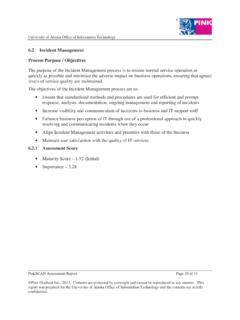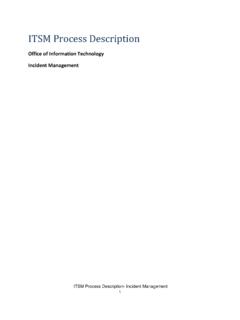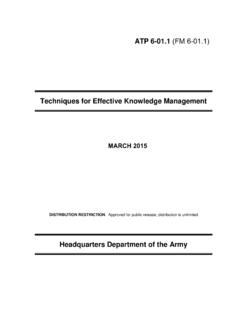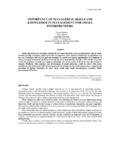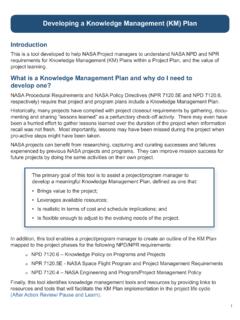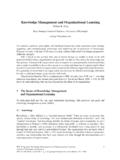Transcription of 6.3 Knowledge Management Process Purpose / Objective
1 University of Alaska Office of Information Technology PinkSCAN Assessment Report Page 46 of 74 Pink Elephant Inc., 2012. Contents are protected by copyright and cannot be reproduced in any manner. This report was prepared for the University of Alaska Office of Information Technology and the contents are strictly confidential. Knowledge Management Process Purpose / Objective The Purpose of the Knowledge Management Process is to share perspectives, ideas, experience and information; to ensure that these are available in the right place at the right time to enable informed decisions; and to improve efficiency by reducing the need to rediscover Knowledge . The objectives of Knowledge Management are to: Improve the quality of Management decision-making by ensuring that reliable and secure Knowledge , information and data is available through the service lifecycle Enable the service provider to be more efficient and improve quality of service, increase satisfaction and reduce the cost of service by reducing the need to rediscover Knowledge Ensure that staff have a clear and common understanding of the value that their services provide to customers and the ways in which benefits are realized from the use of those services Maintain a Service Knowledge Management System (SKMS) that provides controlled access to Knowledge , information and data that is appropriate for each audience Gather, analyze, store, share, use and maintain Knowledge , information and data throughout the service provider organization Assessment Score Maturity Score (Initial)
2 Importance University of Alaska Office of Information Technology PinkSCAN Assessment Report Page 47 of 74 Pink Elephant Inc., 2012. Contents are protected by copyright and cannot be reproduced in any manner. This report was prepared for the University of Alaska Office of Information Technology and the contents are strictly confidential. Figure 6 Knowledge Management Scores University of Alaska Office of Information Technology PinkSCAN Assessment Report Page 48 of 74 Pink Elephant Inc., 2012. Contents are protected by copyright and cannot be reproduced in any manner. This report was prepared for the University of Alaska Office of Information Technology and the contents are strictly confidential. Observations and Conclusions There is no end-to-end Knowledge Management Process . It is currently a decentralized Process with each support team responsible for developing and updating Knowledge within their discrete areas of expertise A Process Owner has recently been identified for Knowledge Management There are documented Knowledge records stored in a Wiki The Support Center is currently the primary user of Knowledge articles produced The Support Center staff document Knowledge articles using templates.
3 These articles are not maintained in HP Service Manager, but reside in a SharePoint site Level 2 resources have access to their own SharePoint Knowledge articles; these are not relevant for troubleshooting by Level 1 support Support Center Knowledge articles are searchable via keywords Knowledge articles are not regularly communicated to the Support Center for facilitating incident resolution Some articles go through a technical review by a Manager or Team Lead at the Support Center There is no regular review of Knowledge articles for relevance and helpfulness Individual groups create documentation on an as-needed basis for use within the group The Desktop Support team is beginning to actively engage in Knowledge sharing with the Support Center; however, there are still challenges in receiving timely information prior to a production release Project Teams and Application groups rarely provide information for the Support Center to capture in Knowledge articles There is a heavy reliance on individual Knowledge and experience These Knowledge Management challenges were expressed during the workshop: o Multiple repositories o No centralized control Knowledge sharing is not institutionalized as part of the UA culture.
4 Most people rely on tribal Knowledge and refer to colleagues for information which is often not documented or readily available, resulting in each group creating and managing information disparately and redundantly University of Alaska Office of Information Technology PinkSCAN Assessment Report Page 49 of 74 Pink Elephant Inc., 2012. Contents are protected by copyright and cannot be reproduced in any manner. This report was prepared for the University of Alaska Office of Information Technology and the contents are strictly confidential. The workshop participants said there is a need for a Knowledge Management Process and database due to the ongoing risk of losing information and Knowledge as people transition from one role to another and/or leave the University University of Alaska Office of Information Technology PinkSCAN Assessment Report Page 50 of 74 Pink Elephant Inc., 2012. Contents are protected by copyright and cannot be reproduced in any manner.
5 This report was prepared for the University of Alaska Office of Information Technology and the contents are strictly confidential. Recommendations Launch an initiative to conduct an inventory of existing portals, documents and information sources as a first step in establishing a Knowledge Management approach Implement a Knowledge Management Process to improve the quality of Management decision making by ensuring that reliable and secure information and data is available throughout the Service Lifecycle to meet business needs Establish the role of an enterprise-wide Knowledge Manager and ensure all support teams are aware of the role, responsibilities and authority in facilitating the effective use of Knowledge required to support UA OIT Establish a Knowledge Management strategy and documentation structure to ensure information and data is captured, stored and accessible Improve integration between Level 2 and Level 3 support teams and ensure operational handoffs and necessary documentation is available to support teams and stored in a central repository well before a production release Develop a centrally accessible Knowledge Database with documents that are standardized, communicated and available to all that need access Provide regularly scheduled role-based and specific application and infrastructure cross-training to backup support staff to ensure adequate Knowledge transfer and Knowledge sharing amongst the support teams Understand and document information or Knowledge that the organization needs: o How does each item of data relate to other data, information and Knowledge ?
6 O Where and how should it be stored? o Who is responsible for collecting, updating and maintaining it? o What legal, regulatory or governance considerations apply to it? o How long is it needed? o How will it be consolidated, archived or deleted when it is no longer needed? o Who should be allowed to access it? o Who should be allowed to change it? Establish document governance and control guidelines with enforceable metrics to ensure documents are regularly reviewed for relevance, currency, accuracy Identify appropriate CSFs based on OIT s objectives for the Process . Some samples include: University of Alaska Office of Information Technology PinkSCAN Assessment Report Page 51 of 74 Pink Elephant Inc., 2012. Contents are protected by copyright and cannot be reproduced in any manner. This report was prepared for the University of Alaska Office of Information Technology and the contents are strictly confidential. o Availability of Knowledge and information that helps to support Management decision-making o Reduced time and effort required to support and maintain services o Successful implementation and early life operation of new and changed services with few Knowledge -related errors o Improved accessibility and Management of standards and policies o Reduced dependency on personnel for Knowledge Develop KPIs appropriate for your level of maturity and CSFs.
7 Monitor achievements against your chosen KPIs and use them to identify opportunities for improvement. Carefully consider the following KPIs for adoption: o Increased number of times that the Service Knowledge Management System (SKMS) is accessed o Increased percentage of SKMS searches by managers and users that receive a rating of good o Increased number of times that material is re-used in documentation such as procedures , test design and Support Center scripts o Increased number of accesses to the SKMS by Service Operation teams o Reduced transfer of issues to other people and more resolution at lower staff levels o Increased percentage of incidents solved by use of known errors o Increased results in Knowledge Management satisfaction survey of Service Operation teams o Reduced number of incidents and problems categorized as Knowledge -related o Increased percentage of successful service transitions o Increased number of standards and policies stored in the SKMS o Increased number of times that standards and policies in the SKMS have been accessed
